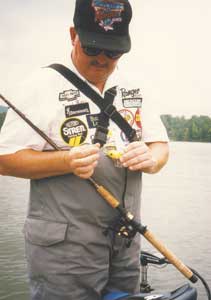
If you spent the winter months at your favorite lake, putting in brush piles or other fish attractors, September is a month when you’ll begin to reap what you sowed. At least that’s the way it’s been in the past.
The first part of September is normally really tough fishing at North Carolina lakes. The water is usually hot, and the fish are really scattered and hard to catch. A lot of times guys will fish at the backs of creeks or upriver, fishing for resident bass that never leave those places.
September is sort of a “split” month to me because the fishing gets a lot better as the month goes along. I know an awful lot of bass will still be in deep water, so a crankbait remains a pretty good choice, along with a Zoom lizard or Big Dead Ringer worm.
It is also the month when wood becomes the dominant cover. Fishing those brush piles you spent all that time building and sinking starts to pay off.
Some of the best days I’ve ever had fishing High Rock Lake have been in the fall when the bass orient at brush piles that are in front of or to the side of boat docks. But brush piles that are at some of the places that bass live during the summer also will be good spots.
If the power companies that own the lakes are moving a lot of water, a good crankbait bite still will occur if anglers use deep-running lures such as a DT-14 or DT-10. The old “carp” color starts to get good in September, and your chartreuses – the old “Homer” or brown-back/chartreuse sides crankbaits really start to produce.
What you have to figure out when you’re fishing brush is where the bass are setting up. And that’s just a question of fishing a crankbait until you get a bite or quit and start fishing a worm.
There have been plenty of times when I’ve pulled up to a brush pile and hit it with a crankbait and caught a fish right away, and there have been other times when I’ve pulled up and made what seemed like 100 casts with a crankbait, then when I put it down and picked up a worm, one hit it on the second cast. The fish that are suspended in the brush piles – and a lot of bass will suspend in September — will hit crankbaits. The ones that are at the bottoms of brush piles will hit plastic worms.
I know most fishermen automatically think “Carolina rig” when they think about fishing deep. But when it comes to brush, I’m strictly a Texas-rig fisherman. I’ll use a big worm weight and a big worm and throw it in that brush. A Texas rig is a lot more effective than a Carolina rig around brush for several reasons: it will drop down through the limbs more easily, it doesn’t get hung up as easily, and in September, a bass won’t really bite distinctly a lot of the time, so it’s much easier to feel a bite with a Texas rig.
When you fish a Carolina rig, you miss a lot more of those subtle bites.
When I fish a worm, I like to go with a dark color. I fish purple a lot, but Junebug is probably my favorite.
A big step you can take that will help in September is swallowing a big gulp of patience. There are a lot of single fish in September, and you fish for five bites a day and hope you get ’em all in the boat.
You don’t go out there thinking you’re going to catch 20 or 30 fish; that’s not gonna happen in September. There are times in early September when a tournament at High Rock will be won by somebody with 12 pounds — but at the end of the month, it’ll take 22 pounds.
As October approaches, the fishing will change totally. The water finally starts to cool off, and the baitfish will move into the creeks. The bass will follow, but a lot of times, the first thing they’ll do is suspend above a channel or a ditch, wandering around, following those baitfish. And those bass are hard to catch.
When they finally get out of that stage, they’ll start moving to the fall patterns that we’ve grown to love. I look to flats with brush piles or the edges of creek channels.
The cooler the weather gets, the better bass will get on creek channels. They’ll start to get on road beds and they’ll go back to docks, and they’ll get on long, flat points.
There are so many patterns that work in the fall — that’s what makes it so much fun.
But first, you’ve got to get through September.
Editor’s note: David Fritts is a 49-year-old professional bass fisherman from Lexington. He was the 1993 BASS Masters Classic champion, the 1993-94 BASS Angler of the Year and the 1997 FLW Tour Champion. His sponsors include: Bass Pro Shops, Evinrude Motors, Ranger Boats, Chevy Trucks, Minn-Kota trolling motors, American Rodsmith, Rapala crankbaits and fishing line, Zoom plastics, Solar Bat sun glasses, Mountain Dew, Gripper (ECS Anchor Supply), VMC hooks, Pro Pocket and Blue Fox.




Be the first to comment